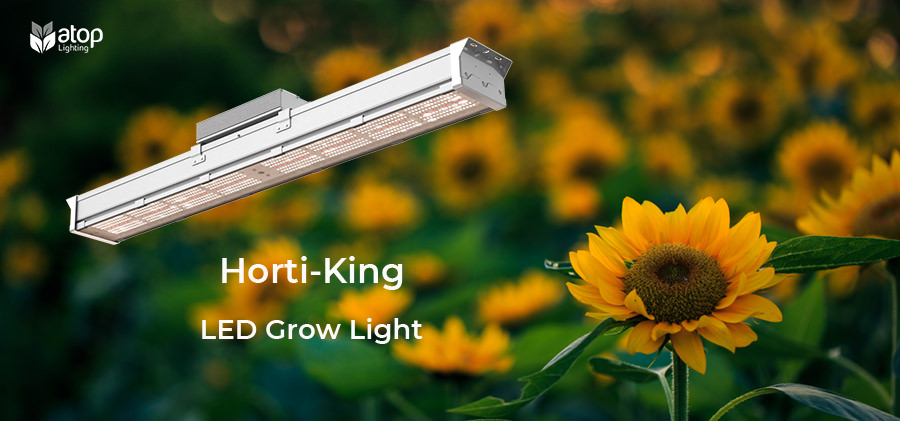Guide to Grow Sunflower Indoors with LED Grow Light
Sunflowers are regarded as the symbol of positivity. Their bright yellow flowers and tall stems evoke an aspiring and energetic feeling. Sunflowers are also known as their tilt heads that always tracking to the sun before blooming during the day. Although outdoor sunflowers are able to absorb more sunlight, they are threatened by chewing insects and birds. Therefore, indoor growing is an alternative and safer optional for sunflowers. It goes without saying that light is critical for sunflowers. Light is the leading source of photosynthesis. LED growing lights, which are designed to mimic sunlight, provide an opportunity for indoor sunflowers growing. Horti-King is one of the LED grow lights that is beneficial for indoor sunflowers. This post would like talk about how to grow sunflower indoors with Horti-King LED grow light.
Why use Horti-King LED grow light
As we all know, sunflowers grow best in full sun environment and they require high light levels. LED grow lights offer sun-like lighting for sunflowers indoor. Horti-King is a full spectrum top lighting solution for sunflower plants. It helps to improve growth as well as achieving year-round production with the typically designed wavelength range that is beneficial for photosynthesis. Efficacy of Horti-King is up to 2.8 µmol/J, contributing to reduce energy consumption and cut electricity bill. Horti-King also has premium quality. Aluminum extrusion profiles enlarge heat dissipation area and accelerate heat conduction, ensure stable performance. No additional assembly is required as Horti-King is easy to mount and ready for installation. The simple installation and operation make it an ideal solution for achieving high and uniform lighting levels in greenhouse and indoor sole-source applications.
What is the right light intensity for indoor sunflower
Appropriate light intensity is varied from the growing stage of sunflower plants. In short, high light intensity is helpful for sunflower growth. Low light intensity will cause disfigured morphology and decrease market value. PPFD (µmol) is used for measuring light intensity of grow lights generally. It means the photosynthetic photon flux density, which measures how much active photons fall on a given surface of the plant. But PPFD is changed with coverage area and height. To calculate the light intensity and manage the supplemental lights more precisely, DLI (Daily Light Integral) is introduced. DLI (mol·m-2·d-1 ) is the amount of PAR delivered per unit area during 24 hours. There is no additional requirements of light intensity during germination stage. DLI ranged from 12 to 16 mol·m-2·d-1 is recommended for caring young plants. When sunflower bud emerges, the DLI can be increased up to 20 mol·m-2·d-1.
How many hours should be illuminated for indoor sunflower
The illuminated hours for indoor sunflowers are related with the photoperiod of sunflowers. Photoperiod refers to period of time that plants are being able to receive light in 24 hours. Plants are classified to long-day plants, short-day plants, and day-neutral plants. Long-day plants initiate flower when photoperiod is long (duration of day length longer than night length). In contrast, short-day plants will flower when duration of day length shorter than night length. Day-neutral plants, however, do not have response to the photoperiod. Growth and development of most sunflower cultivars are affected by photoperiod. ‘Frilly’ is one of the long-day sunflower cultivar. ‘ProCut orange’ and ‘Sunrich gold’ are short day plants. ‘Soraya’ and ‘the Joker’ are nay-neutral plants. Specific illuminated hours for indoor sunflowers should be scheduled according to the cultivar of sunflowers. For example, a photoperiod less than 12 hours is positive to promote flowering for short-day sunflowers.
Photoperiod should also be arranged by growing stage of plants. Supplemental lighting is not required during germination stage. Since most sunflower cultivars are long-day plants, a photoperiod more than 13 hours but shorter than 20 hours can improve flowering.
What to do when natural pohtoperiods do not match sunflower growth
Photoperiod is essential to the development of sunflowers. If natural photoperiods do not match the growth of sunflower plants, we should take actions to adjust duration of ‘day length’. If the natural photoperiods are too long, we can shorten the photoperiods by blocking out the light that shine sunflowers. Black covers with plastic or cloth material are generally used for to against natural light. After the covers are pulled over sunflowers, we should pay attention to the small gaps where light is possible to lit the sunflowers. But this activity may cause the heat accumulation, which can kill the plants. To avoid heat accumulation, we can choose the aluminum shields to reflect the sunlight. We can also pull the covers before sunrise. Because the temperatures before sunrise are lower, it is of less possibility to accumulate heat. If natural photoperiods are too short to initiate flowering, we can extend the photoperiods through delay the time of lighting or breaking up night lighting. For example, when the natural photoperiod is only 10 hours, we can supplement 3 hours of lighting after sunset to achieve a 13 hours photoperiod.
In conclusion, the lighting recommendations for indoor sunflowers (long-day plant) are as followed:
|
|
Germination |
Young Plants |
Flowering |
|
DLI (mol·m-2·d-1) |
- |
12 - 16 |
12 - 20 |
|
Photoperiod (hours) |
- |
12 - 20 |
12 - 20 |
Need LED grow lights for your commercial greenhouse or indoor grow rooms?
Don't hesitate to contact us.


